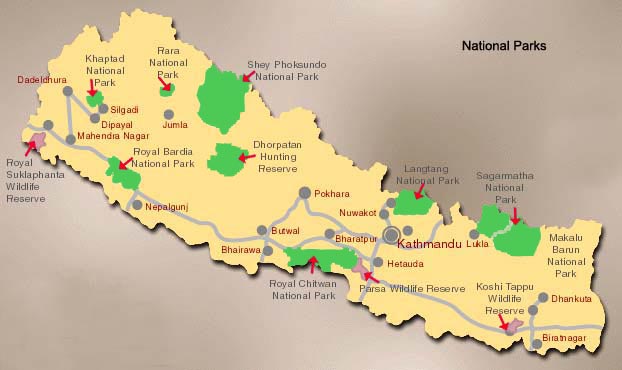 Bardia National Park
|
The Royal Bardia National Park was initially a Royal hunting reserve. It was in
1976 that it was gazetted as Royal Karnali Wildlife Reserve with an area of only 368 sq. KM in 1982, It was renamed as Royal
Bardia Wildlife Reserve Which also included the Babai River Valley. It was only in 1988 that is was granted a status of National
Park in order to preserve the dwindling species of rare ecosystem, including flora and fauna, particularly the tiger and its
other prey species. This park is the largest and most undisturbed wilderness area in the terai p[providing excellent habitat
for most of the endangered species of wildlife and birds. The park now covers an area of 968 sq. KM. It was only 1994 basic
facilities existed for independent visitors. It has extensive and varied wildlife-all endangered rhinoceros, Wild elephants,
The Royal Bengal Tiger, Swamp deer, Black buck, Gharial Crocodile, Gangetic Dolphins.
More than thirty different mammals, over 400 species of birds, many snakes, lizards
, and fish have been sighted and recorded in the park's forest, grassland and river habitats. |
| Among these include, Langur monkey, common leopard,
Jungle cat, fishing at, large and small Indian civets, mongoose, hyena, wild dog, jackal. sloth bear, otter, porcupine, bandicoots,
blue bull (Nilgai), Sambar deer, hog deer, barking dear, wild boar etc. This park is one of the best place to view the most
magnificent of cats, The Royal Bengal Tigers. The chance are almost 80% depending on season. |

 Nature walks Nature walks
 Bird watching Bird watching
 cycling tours to black buck area cycling tours to black buck area
 isolated villages isolated villages
 visit to the Karnali Bridge. visit to the Karnali Bridge. |
 Elephant safaris, Elephant safaris,
 Jungle drive Jungle drive
 Tharu culture programme, Tharu culture programme,
 Canoeing Trips Canoeing Trips
 Rafting Rafting |
|

